[Press trip] A whole house just for LEGO – sounds like a dream, right? For our daughter, it was exactly that. But for us parents, the visit to the LEGO House in Billund was also an unforgettable experience and a look back into our own childhood. We had already visited LEGOLAND, but the LEGO House was new to us and turned out to be completely different, more intense and surprisingly emotional.
Inhalt
ToggleIn this article, we’ll take you into the heart of the LEGO world: We’ll tell you what particularly inspired us as a family, which areas are particularly suitable for children, why we would have preferred to stay for several days, and give you practical tips on how to make your own visit a complete success.
Location: The LEGO House in the middle of Billund
Billund is a small, manageable town in southern Denmark – but a real place of pilgrimage for LEGO fans worldwide. LEGO was invented here, the first LEGOLAND in the world is located here, and the impressive LEGO House is located here. Everything is so close together that you can easily get around on foot – ideal for families with children.
The LEGO House itself is centrally located in the town, just a few minutes’ walk from LEGOLAND and the LEGOLAND® Holiday Village. We were traveling in a camper and stayed at the campsite, so we could easily walk over. If you arrive without your own vehicle, you don’t need a bus or bike here – everything in Billund is within walking distance.
Even from the outside, the modern building is hard to miss: the staggered architecture is reminiscent of stacked LEGO bricks. This is not only visually impressive – it also signals what awaits you inside: a place to participate, marvel and discover.
Despite the tourist focus, Billund is pleasantly quiet, tidy and very family-friendly: perfect for a break in the sign of the colorful bricks.
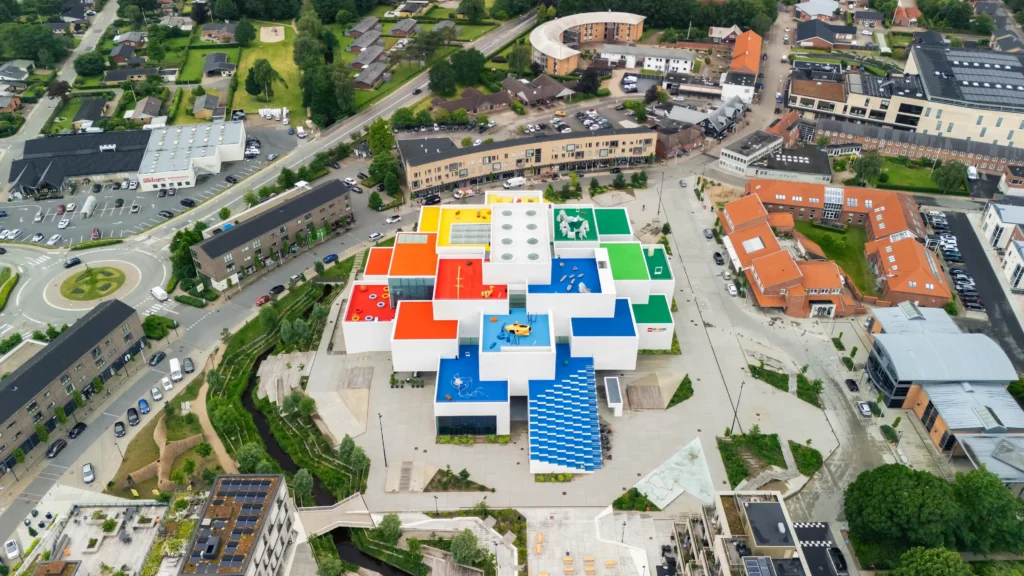
What is the LEGO House?
The LEGO House in the heart of Billund describes itself as “probably the world’s largest playhouse” and was opened in 2017. On 12,000 square meters, it offers everything that makes the hearts of small and large LEGO fans beat faster: over 25 million bricks, six themed areas, a digital LEGO archive and even its own restaurant where robots serve the food.
The building was designed by the Danish architectural group Bjarke Ingels Group (BIG). The architecture is reminiscent of oversized, stacked LEGO bricks. On the various roof terraces there are playgrounds that thematically match the world of LEGO.
As soon as you enter, you can feel that the focus here is not on consumption, but on creativity. The first thing you see is the impressive “Tree of Creativity” in the foyer – a 15-meter-high LEGO tree made of six million bricks. From there you can reach the various experience zones, where children and adults can build, program and experiment together.
For us, it was immediately noticeable: The LEGO House is not a museum, not an amusement park – but a modern, well-thought-out playroom in which children and parents are equally addressed. It combines classic LEGO bricks with digital elements and creates an atmosphere that is equally playful, inspiring and surprisingly emotional.
Our way through the LEGO House
Arriving and Marveling: Six Bricks Experience and the Tree of Creativity
After entering the LEGO House, we stood directly in the open entrance area, the so-called LEGO Square. Everything here is bright, spacious and designed entirely for arriving and discovering. Our daughter was immediately attracted by the huge Tree of Creativity in the middle. It rises to the ceiling, consists of six million LEGO bricks and shows in its detailed scenes well-known LEGO worlds that amaze young and old.

To the right of the entrance, a playful introduction awaited: the Six Bricks Experience. With just six LEGO bricks, children and adults could experiment creatively. Particularly fascinating: exactly these six bricks can be used to build over 900 million different combinations. This was not only exciting for our daughter, but also a surprising aha moment for us adults.
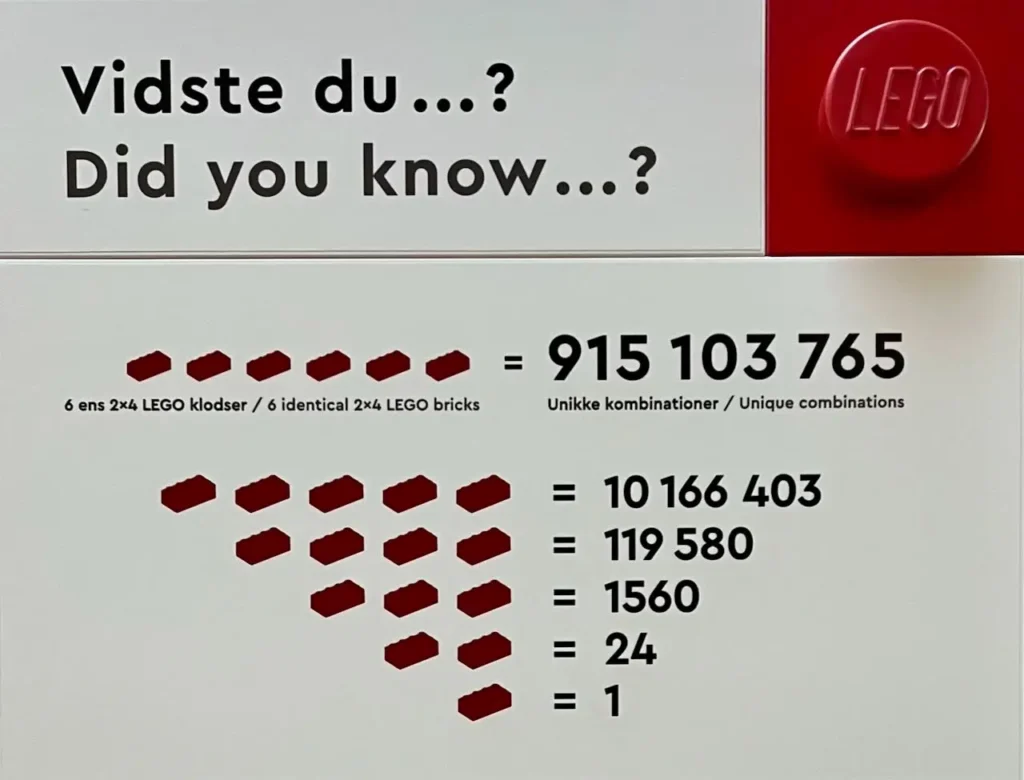
Another highlight on the ground floor is the small LEGO production machine, where you can experience live how a LEGO brick is made. From the granulate to the shaping to the packaging, everything runs visibly behind glass. At the end you even get a small bag with exactly the six bricks you played with before – a nice souvenir and a tangible symbol for the basic idea of the house: move infinitely much with few bricks.
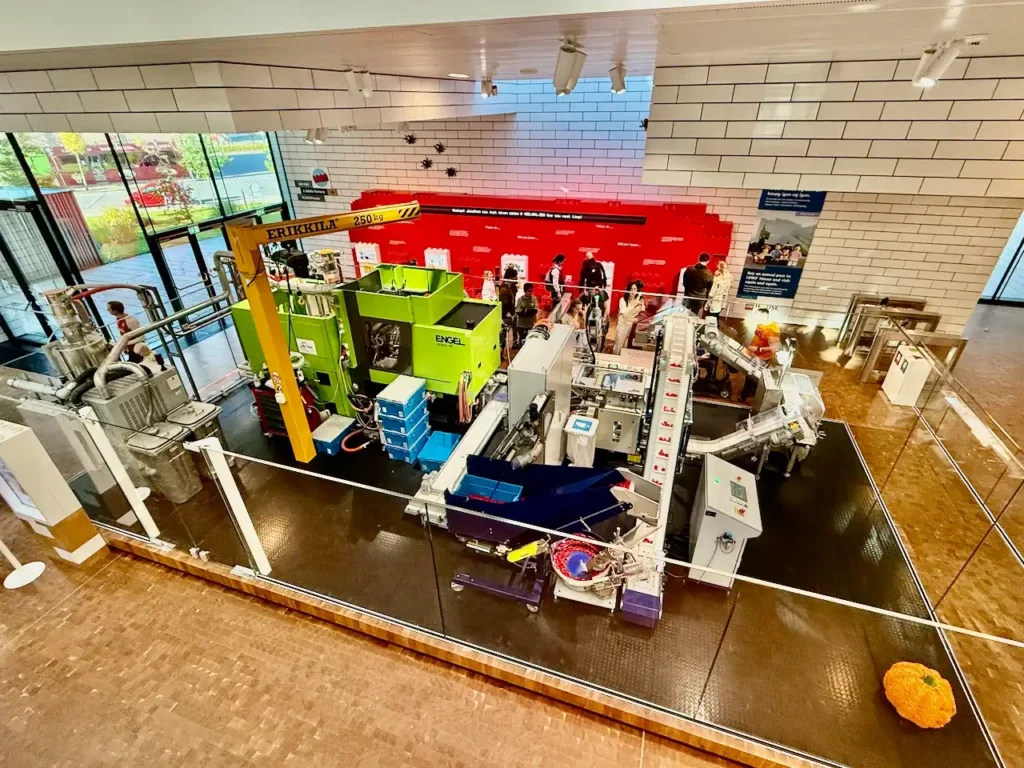
The LEGO Square leads further to the upper levels with the color-coded experience areas. But it is already clear on the ground floor: The LEGO House is not a loud amusement park, but a place to explore, understand and participate – in a very individual way.
Marveling at the highest level: The Masterpiece Gallery
At the very top of the LEGO House, where the light falls through large windows, lies a quiet, almost solemn place: the Masterpiece Gallery. For us, it felt like a tribute to the imagination – less for participating, but for pausing and marveling.
When we arrived at the top, we stood in front of three impressive LEGO dinosaurs, which were made from different construction systems: one made of Duplo, one made of classic LEGO bricks and one made of Technic elements. Each one seemed special in its own way, and we were particularly fascinated by the contrast between the construction methods.

The gallery itself shows works by adult LEGO fans from all over the world. No instructions, no standard set – just pure creativity. Some models looked like sculptures, others like living fantasy worlds. Our daughter was quieter than usual, looked at the figures with big eyes and asked quietly: “Did someone build that alone?” Yes, that’s exactly what makes this area so special. It shows what is possible with LEGO when imagination meets patience and passion.
Participate, Invent, Experience: The Experience Zones in the LEGO House
There really is something for everyone in the LEGO House. During our visit, we met many families with babies and toddlers who strolled through the areas in a relaxed manner, played or took a break in the quiet corners. At the same time, we saw enthusiastic LEGO fans who were highly concentrated on their own buildings. Some were so engrossed that they forgot everything around them.
The heart of the house is formed by four large experience areas, which are color-coded: red, yellow, green and blue. Each area has its own focus. They are complemented by two exhibitions, several roof playgrounds, a small café and the family-friendly Mini Chefs Restaurant, where you can put together your food with LEGO bricks. This makes the visit not only creative, but also a culinary experience.
Everywhere you will find both classic LEGO bricks and LEGO Duplo elements for younger children. Between the areas there are retreat zones with headphones and seating, which is a valuable addition especially for families with small children.
🔴 Red Area: Creativity without Limits
The red area was like a huge adventure playground made of bricks for our daughter. Right at the beginning, we were impressed by the waterfall made of LEGO. We built monsters, photographed them with the LEGO camera and took the pictures with us later as a souvenir. There was also a large free building area for all age groups and a small café stand, which was ideal for a short break.
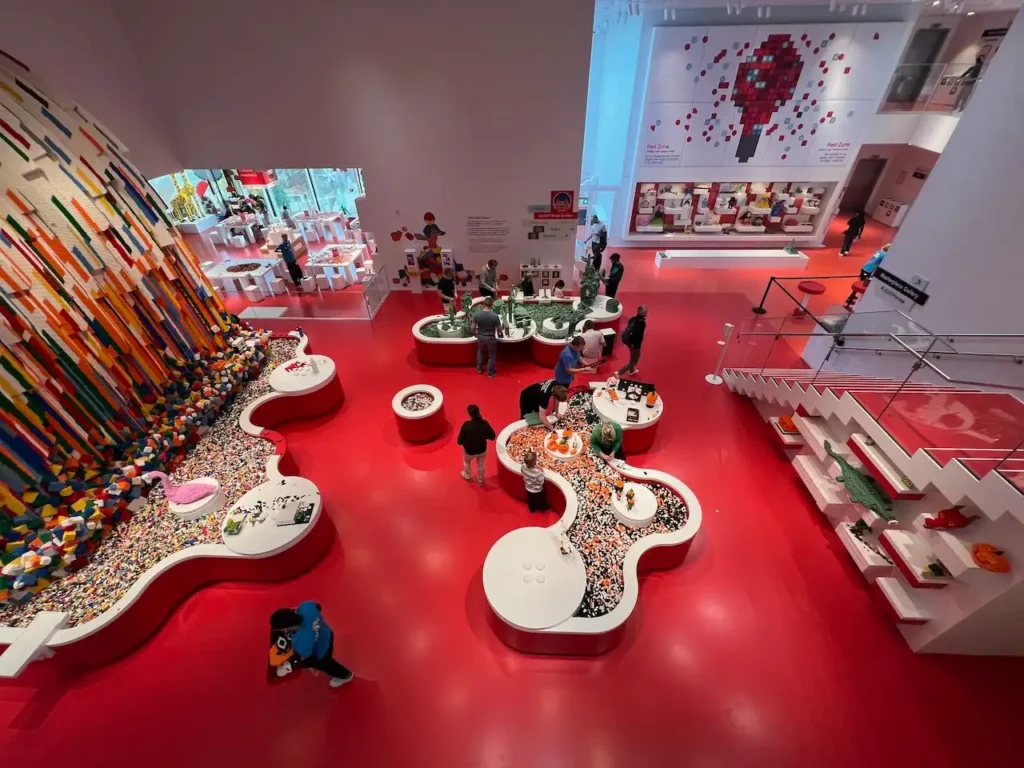
🟡 Yellow Area: Imagination and Movement

🟢 Green Area: Telling Stories and Shooting Animated Films
Here we could shoot our own animated film together. There were two pre-built LEGO scenes to choose from. We decided on a pirate adventure and staged our story with figures and props. Next door you could design your own minifigures and then have them photographed as a cover star on a LEGO magazine. We found the large LEGO worlds to look at particularly impressive. For example, there was a tropical island with a volcano or a detailed mountain landscape with a cable car. We could have stayed for hours.

🔵 Blue Area: Technology, Future and Nature
The blue area was about future topics and technology. Together we built habitats of the future and considered what a sustainable world could look like. At “Build the Change” we were able to plant flowers with the help of a robot and provide bees with nectar. Our daughter was thrilled with how playfully natural history was taught. The racing car project was also a highlight. We built our own vehicle and had it compete against others on a test track. However, not every car was stable enough for a race. Some fell apart halfway or reached the finish line only in individual parts.

Flashback with goosebumps: The LEGO History Collection
At the end of our tour through the LEGO House, the path led us to the basement. There is the LEGO History Collection, the official museum of the house and at the same time a quiet, almost solemn conclusion to the interior. After all the colorful, lively experience zones, it was a place to pause, remember and marvel.
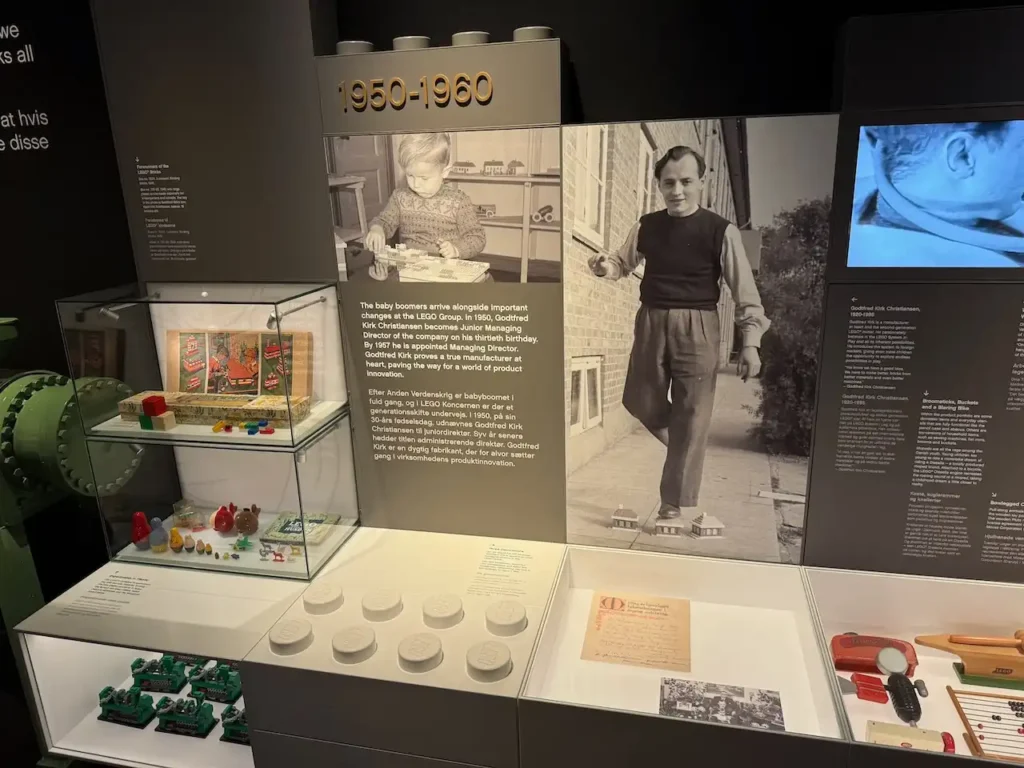
We learned that LEGO was originally made of wood. The story began in a small carpentry shop in Billund – with wooden toys such as the famous red duck, which is now a central symbol of the early years. We were even able to touch some of these historical objects. For the visually or hearing impaired, there is additional information in Braille, sign language and audio versions. It was noticeable that inclusion was really taken into account here.
The majority of the exhibition was in showcases, sorted by decades. Our daughter was rather quick through, while we parents went from set to set and remembered a lot. Knight castles, pirate ships, construction site vehicles – all that we used to play with ourselves. Again and again there was this moment when we discovered a set and spontaneously said: “I had that too!”
A special highlight for us adults was the possibility to compile our very personal LEGO collection from a huge digital collection. On a large screen we could browse through the decades – from the beginnings in the 60s to the golden 80s and 90s to current sets.
What happened was more than a little nostalgia. Again and again sets appeared that we had owned ourselves: the old police car, the knight castle with drawbridge, the pirate ship that we rebuilt countless times. We had long forgotten many of these sets – and suddenly they were back, in color, with names and part numbers.
We clicked each other through our memories, laughed, showed us the models like old photos. It was almost as if we were not only remembering toys, but certain phases of life – birthdays, Christmas or rainy afternoons in the children’s room. The possibility to digitally place these personal favorites on your own LEGO shelf was like creating a very personal LEGO memory.
This experience was not loud or spectacular – but deeply moving. A quiet, digital moment that told almost more about ourselves than about LEGO. For us it was the perfect end to our tour through the building.
After we had explored the experience zones, we were drawn outside – because real play and discovery moments await on the roof of the LEGO House.
Playing with foresight: The roof terraces of the LEGO House
Before we finally said goodbye to the LEGO House, our path led us to the very top. The publicly accessible roof landscape is not only architecturally exciting, but also a real insider tip for anyone who wants to experience the LEGO House without an entrance ticket.
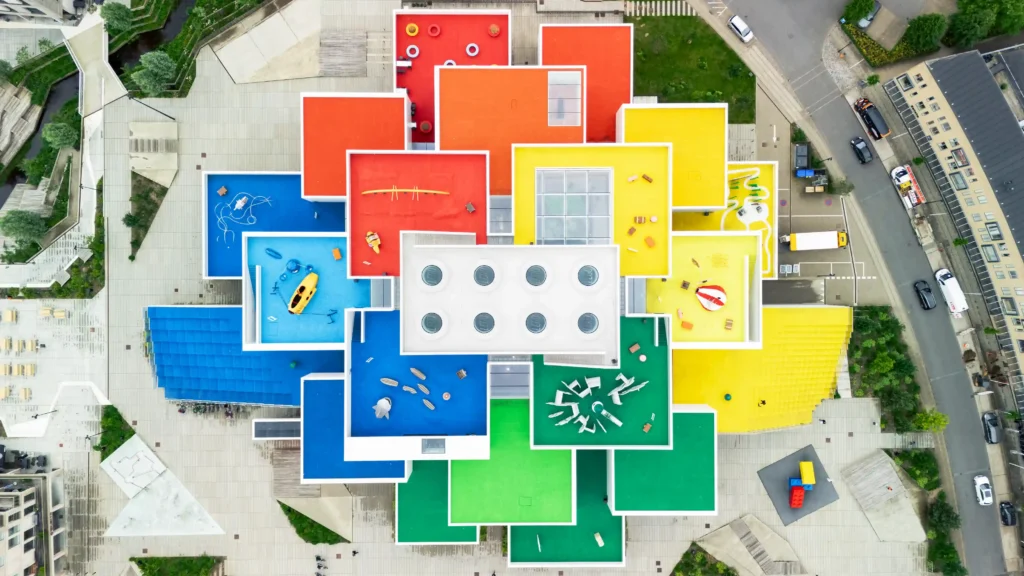
Several colorful play terraces, which look like oversized LEGO bricks, invite you to romp, climb and marvel. Each level is dedicated to its own theme and offers varied play possibilities – sometimes for balancing, sometimes for hiding or simply for romping around. Our daughter was thrilled and hopped from terrace to terrace, while we parents enjoyed the wide view over Billund.
Even the way up is a small experience: Either you climb the offset levels via several external stairs, which are distributed around the building, or you can take the elevator directly from the entrance to the very top. We decided to take the elevator – and then walked down over the various play terraces.
Once at the top, you realize how special this building is: You stand in the middle of an architectural work of art, which is also a huge playground. It is quiet, spacious and colorful. You hear the laughter of the children, see families sitting relaxed on the benches and can simply breathe through yourself.
Especially in good weather, this area is a wonderful place to linger, leave the hustle and bustle inside behind and still stay fully in the LEGO universe. A free conclusion for an all-round successful visit.
After so many impressions, we had earned a break – and the LEGO House is well prepared for this: with an experience restaurant that is second to none.
Culinary experience in the LEGO House: Restaurant Mini Chef and Café Brickaccino
A day full of discoveries makes you hungry – and the LEGO House has a lot to offer here. Our highlight was the visit to the Restaurant Mini Chef, which convinced not only with its concept, but also with its design. Reservations are a must, because the restaurant is popular and without a table usually nothing works. Fortunately, we had booked a table online in advance.
Already when entering it is noticeable: Everything is geared towards families. LEGO bricks are available everywhere for the children to build with. There are books to browse and space to spread out. We sat on comfortable benches, surrounded by other families. The atmosphere was relaxed, lively and child-friendly.

Orders are not placed in the traditional way, but playfully with LEGO bricks. Each color represents a specific category – for example, meat, side dish, vegetables, and salad. Our daughter was fascinated by putting together her own menu with small LEGO bricks. By the way, we were allowed to take these bricks home as souvenirs. You had to scan the finished order yourself at a terminal at the table, and a short time later you could pick up your food from a friendly robot. Not a classic plate, but a real eye-catcher – a two-story LEGO box.
We were pleasantly surprised by the quality of the food. I had salmon with potatoes, tomato-mozzarella salad, and vegetables – all fresh and delicious. Our daughter had chosen pasta, chicken breast, and fruit. There is also a LEGO figure as a surprise for children. She wasn’t entirely convinced by the taste, as the pasta was quite oily, but she still enjoyed the experience. For adults, the menu was well-rounded – varied, high-quality, and filling.
They also cater to allergies and intolerances. Drinks are ordered separately on the screen, and bread and butter were available on the table beforehand. In total, we were in the restaurant for about an hour – enough time to fortify ourselves and take a breather.
An important tip for all visitors: The Mini Chef Restaurant and the Brickaccino are also accessible without admission to the LEGO House. So you can leave the exhibition with your admission bracelet, go out to eat, and come back later. Or you can visit the restaurant on a different day than the exhibition itself. Especially for families, it’s a great way to stay flexible.
And if you can’t get a table at the Mini Chef or are simply less hungry: The Brickaccino café is the perfect alternative. There are smaller meals, cakes, snacks, and coffee – ideal for a break in between or a light lunch.
Our conclusion: Eating at the LEGO House is more than just a meal – it’s part of the experience. The Mini Chef in particular will be remembered: well thought-out, lovingly made, and full of LEGO magic.
Before we left the LEGO House in the late afternoon, we had one last stop on the agenda: a visit to the in-house LEGO Store.
Shopping with style: The LEGO Store in the LEGO House
At the end of our visit, we made our way through the official LEGO Store on the ground floor. Admission is possible without a ticket – and the crowds were correspondingly large. No wonder, because this store is anything but ordinary: In addition to the well-known sets, you will also find exclusive products that are only available at the LEGO House.

The undisputed highlight for many visitors was the opportunity to create your own LEGO minifigure. There was an impressive queue at the station where you could select individual parts and even have the torso printed – a real souvenir with memorable value.
We ourselves took a LEGO keychain with us. However, I was particularly impressed by the model of the LEGO House itself. It is reproduced in detail and impressively shows the special architecture of the building – a real collector’s item that is exclusively available on site.
If you love LEGO, you should definitely plan some time here – whether for browsing, marveling, or shopping.
As a conclusion to our visit, here’s a tip for anyone who likes to browse the LEGO Store in a relaxed manner: It’s busy in the evening. Many visitors deliberately put their shopping at the end of their day in the LEGO House – and the queues get correspondingly long, especially at the Minifigure Factory and the Mosaic Maker. If you want to avoid this, you should visit the store in the morning or around lunchtime, ideally on a different day. Admission is free and independent of the LEGO House ticket.
Our conclusion: An experience that inspires – for young and old
The visit to the LEGO House exceeded our expectations. We wondered why we hadn’t heard of it much earlier – because anyone who likes LEGO will love this place.
As soon as an adult enjoys LEGO and a child plays with Duplo or classic bricks, a visit is definitely worthwhile. Children from 3 years pay admission, but it is an experience for the whole family. The target group is not limited – on the contrary: every age group discovers something different here. While the little ones enjoy animated figures and colorful play areas, adults immerse themselves in memories of their own construction sets or let themselves be surprised by the Mini Chef’s culinary delights.
We also found the personal bracelet that you receive upon entry to be particularly successful. It contains an RFID chip that allows you to interactively navigate throughout the LEGO House. Whether taking photos in the Masterpiece Gallery or saving your own buildings and experiences – everything can be controlled via it. We were able to easily download the resulting photos and videos at home – a nice memory that rounds off the day.
Our personal highlights? For us adults, it was the extraordinary Mini Chef restaurant and the impressive History Collection in the basement. Our daughter, on the other hand, was fascinated by the huge LEGO tree in the center of the house and by the figure that she could build herself and then make dance virtually – a real wow moment.
We also liked the fact that the content is constantly changing: The experience areas are adapted seasonally, so that even a second or third visit holds new surprises. One thing is certain for us: We’ll be back.
FAQ – Frequently asked questions & practical tips about the LEGO House
You should plan the whole day, because you pay for a day ticket anyway. We were there from 10:00 a.m. to 5:30 p.m. and found this time just right:
We spent an hour eating in the Mini Chef restaurant, around 30 minutes on the roof terraces, and in addition to the experience zones, we also took time for the Masterpiece Gallery and the History Collection.
Of course, you can also explore the experience areas in half a day. But if you really want to experience and enjoy everything – including breaks and without stress – you should plan a full day.
The LEGO House is an indoor experience and is therefore good to visit all year round – even in rain or snow. In summer, there are often more tourists in Billund, while it is usually quieter in spring and autumn. In addition, the house is decorated seasonally, which makes a repeated visit worthwhile.
A valid ticket is required for the Six Bricks experience, the Tree of Creativity, the four experience zones, the Masterpiece Gallery and the History Collection.
On the other hand, the LEGO Store, the Brickaccino café, the Mini Chef restaurant and the free outdoor area on the roof are accessible without an admission ticket.
Yes, with the ticket you receive a personal bracelet that allows re-entry on the same day. This allows you to leave the building at any time – for example, for a visit to the restaurant or a break on the roof terrace – and then return in a relaxed manner.
As soon as children play with DUPLO and adults enjoy LEGO, the visit is worthwhile. Our daughter was five years old when we visited and was completely thrilled. There is also a lot to discover for adults – for example in the Masterpiece Gallery, the History Collection or at the Mini Chef robot restaurant.
However, if you only want to go to the LEGO House for the sake of the child without having any interest in LEGO yourself, you should plan the visit from around the age of 6 – then children can discover more for themselves and enjoy the offers for longer.
Children from 0–2 years have free entry. From the 3rd birthday, children pay the same price as adults. Prices are seasonal and in 2025 are around €32–45 for a day ticket and €22–36 for an afternoon ticket.
The exact price depends on the date of travel and the current exchange rate (Danish kroner). You can find availabilities and online tickets directly on the official website of the LEGO House.
Transparency note: We were invited to the LEGO House as part of a press trip. Admission, travel and accommodation at the campsite were provided free of charge. Our opinion remains unaffected – we report authentically on what we liked and what is relevant for families with children from our point of view. This article does not contain paid advertising, but is based on an invitation for research purposes.




